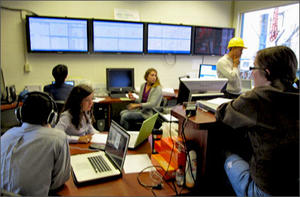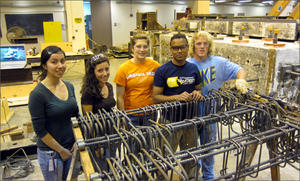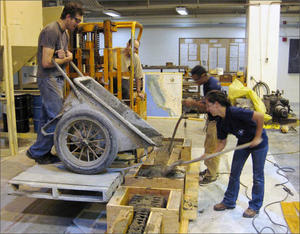In the summer of 2010, PEER was pleased to provide ten students the opportunity to participate in the PEER Summer Internship Program. This unexpected wealth of interns, made possible with student funding from various internship programs, provided PEER with a rich, diverse cohort of students based at the UC Berkeley earthquake engineering laboratories. Eighty percent of the students were from historically underrepresented groups in engineering. Students received support and funding from various agencies including NEES, CalTeach, ENSTIB, UCLEADS, Jack Kent Cook Foundation's TAP, NSF and PEER.
View the intern research papers and posters at the end page.

Victoria Servin, a community college student from Chabot College in Hayward California, and Clayton Sorenson, a UC Santa Cruz undergraduate, investigated the use of some high-tech equipment for earthquake reconnaissance applications under the mentorship of Dr. Shakhzod Takhirov, who had just returned from reconnaissance in Haiti. Ms. Servin worked with some existing software to refine a technique to stitch together high-resolution damage images to create a 3-D panoramic movie of a damaged area. Mr. Sorenson developed a manual for future researchers that shows them how to use a Leica scanner to create high quality laser scans of a damaged buildings and how to extract measurements and data from these 3-D scans.

Ariel Creagh, from University of Texas at Austin, and Cristian Acevedo from Florida International University, conducted experimental testing related to seismic failures of concrete buildings from the 2010 Chile Earthquake under the mentorship of Professor Jack Moehle. Damage from the long duration Chile earthquake included some bar buckling and fracture failures in shearwall boundary elements never before exhibited in past US earthquakes. The intern research project was created to see if this damage pattern could be replicated laboratory setting by applying both tension and compression loads to concrete shearwall boundary elements designed according to US codes. Ms. Creagh designed, constructed and tested two special boundary element specimens and Mr. Acevedo designed, constructed and tested two non-special boundary element specimens. This work will supplement the findings of the NEES Grand Challenge Project: Mitigation of Nonductile Concrete Risk.

Maura Torres, a rising junior at UC Berkeley, assisted with the analysis and construction of concrete columns being tested under vertical excitation at the PEER operated UC Berkeley shaking table with the support of her mentor Pardeep Kumar. Ms. Torres learned how to use SAP and the necessary concrete design to accurately develop the model of the concrete column test specimen.
Katie Zadrozny, from Virginia Polytechnic Institute and State University, assisted UC Berkeley graduate student Ken Ogorzalek with the post-processing and evaluation of data related to a shaking table test of a seismically isolated bridge specimen with segmental displacement control devices. In the process she learned how researchers gather both quantitative and qualitative data from testing, and how they use that data to develop conclusions and explain their research to others.
Two visiting interns from ENSTIB in France, Marie Klop and Laura Bernard, worked with engineer Kelly Cobeen to build, instrument and test wood framed cripple wall. The cripple wall was partially retrofitted with plywood on one half of the specimen and left without reinforcing on the other half. Kelly Cobeen hopes that this research will provide some experimental support to the code provisions for retrofitting timber cripple walls for low-rise wood construction, especially single family homes.

Justine Woo traveled to her internship at UC Berkeley from her home campus Saint Martin's University in Washington. While at Berkeley she worked closely with graduate students Tracy Becker and Charlotte Wong to complete analyses related to the NEEStips Project, Tools for widespread Implementation of Protective Systems. She used new software tools, like PACT and other methods, to better quantify nonstructural and structural earthquake performance of different fixed base and isolated buildings in terms of downtime, damage and repair costs.
Ray Hooft worked closely with UC Berkeley graduate student Jiun Wei Lai to conduct a comparison study of several different configurations of buckling restrained braced frames in a theoretical building. Mr. Hooft used SAP 2000 for the first time to complete a linear elastic computer analysis then worked with Mr. Lai to study the results and develop conclusions about which brace configurations were the most advantageous. His work will be used to enhance the design configuration of experimental testing for the International Hybrid Simulation of Tomorrows Concentrically Braced Steel Frames Project underway at UC Berkeley. Ray Hooft is a student at the University of Nevada, Reno.
Despite the amount of work involved in their research projects during the summer, the interns still had time to participate in a few other learning activities. These activities included:
- – Orientation program including a campus tour, safety training and introduction to PEER,
- – Introductory OpenSees Workshop run by Frank McKenna the OpenSees developer,
- – Hybrid Simulation Workshop organized by graduate student Hong Kim, and
- – Field Trip to the Center for Geotechnical Modeling (CGM) and the nees@davis lab at UC Davis, including a chance to examine the specimen being tested by graduate student Ben Mason and to see the centrifuge spinning!

To ensure that the students learned from all the student projects, not just their own research, weekly meetings were held for the interns and their mentors. Each week various interns were required to present their research progress and discuss the challenges they�d been dealing with. These meetings and the subsequent barbeque lunches, helped to inform the students of the various projects and research approaches, develop their communication skills, and enhance the camaraderie amongst the interns.
Finally at the conclusion of the 10-week summer program the students had the opportunity to show off their research results in final oral presentation and in a concluding poster session for a large group of graduate students and researchers based at UC Berkeley.
Based on some preliminary data and quotes gathered from the post-internship evaluation, the program had a large impact on the participating students. One intern wrote, �The experience made me realize that I certainly want to go to graduate school� and �Earthquake engineering was a slight interest before but now is a huge interest.� Another intern commented, �I loved this summer experience in Berkeley because of the people I worked with. Speaking to my grad student helped me better understand the life of a phd candidate. Now, I have a feel for what is to be expected when I apply. My faculty mentor was very kind and supportive, so I felt comfortable in the lab and could see myself doing that.�
PEER thanks all the interns for their hard work during the summer and all the mentors for the dedication to their student interns!



posted September 14, 2010
